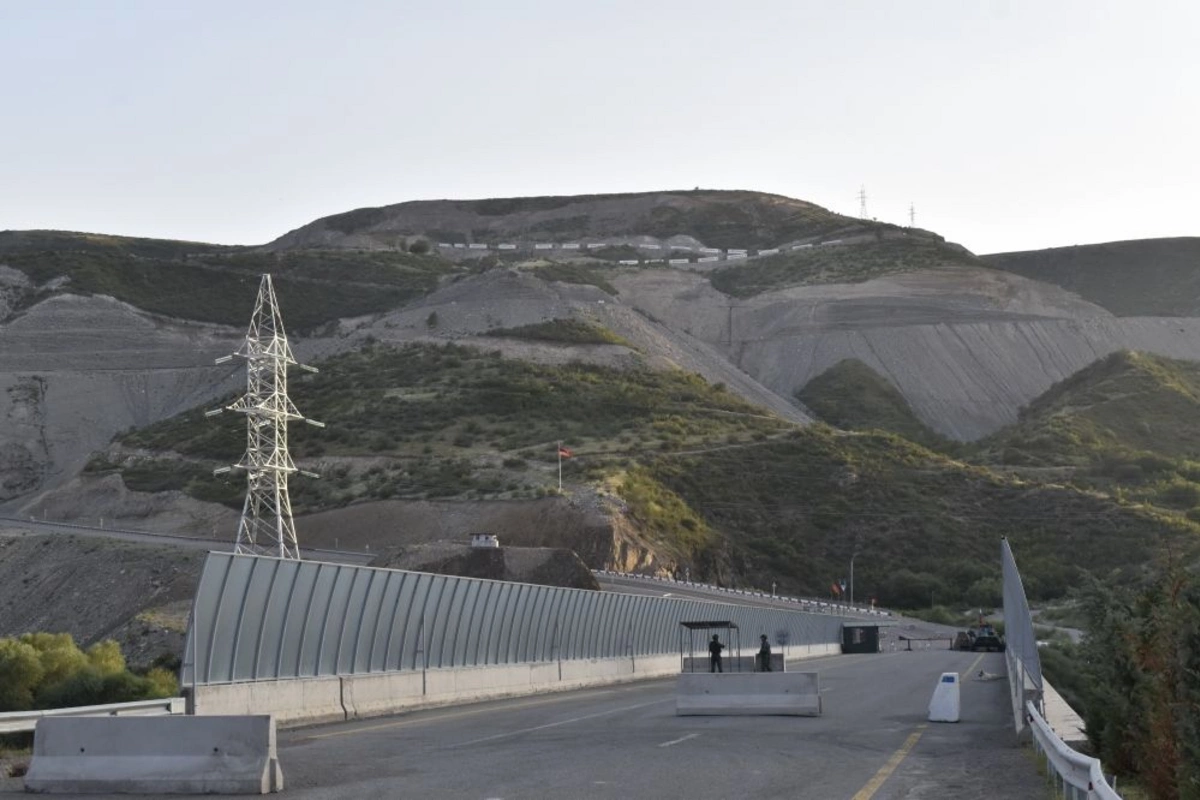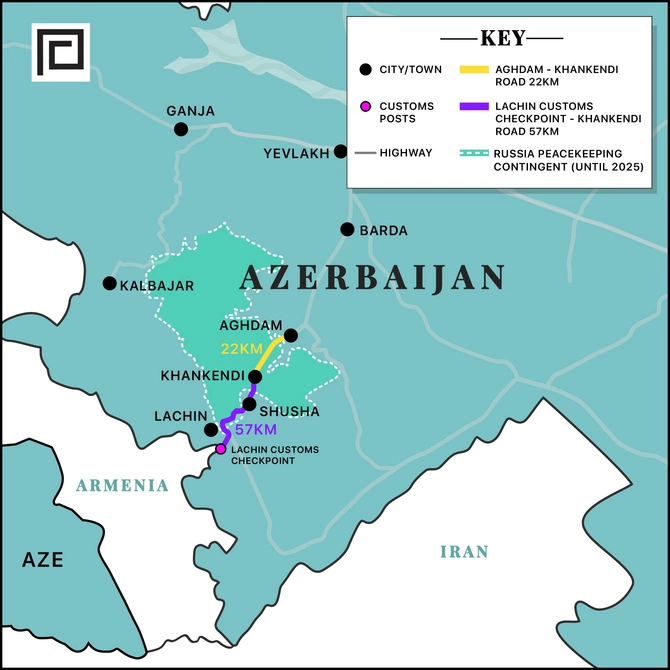
In 2014, when Russia proposed sending convoys of ‘humanitarian aid’ to prop up its de-facto puppet states in Eastern Ukraine, the West reacted angrily. However, this month the EU and UN backed Armenia’s attempts to send a convoy to Karabakh. Hypocrisy?
Image: azernews.az
In the continuing saga of relations between Armenia and Azerbaijan since the end of the Second Karabakh War, one of the last major sticking points in the push for a stable resolution and peace treaty remains the question of supply routes for the Karabakh Armenians.
Azerbaijan’s establishment of a checkpoint in Lachin in April 2023, right at the border with Armenia, was clearly the most significant event after the end of the war in 2020. Although Azerbaijan continued to allow for civilian passage through the border since then, it has instituted limitations on cargo transfer from Armenia to Azerbaijan proper onto its Karabakh region.
For two weeks, 19 trucks have been sitting at the Armenia-Azerbaijan border. Yerevan says they’re carrying ‘humanitarian aid’ that’s essential for the well-being of Armenians living in Karabakh. Baku says that such supplies should go via Aghdam. The result has been a propaganda war. And what’s curious when analyzing the situation is the degree to which the very term ‘humanitarian’ has become politicized.
The case of the Karabakh Convoy has parallels with a case in 2014, when Russia had fairly effortlessly grabbed Crimea from Kyiv’s control but was then struggling to hold onto additional territories, which it had also taken over in Eastern Ukraine. At this stage (unlike in 2022), Vladimir Putin was not keen to mount a full invasion, so one of the tools under consideration to help consolidate pro-Russian rule in the occupied areas was one of the ‘humanitarian aid’ convoys. The idea was described by some as “Putin’s Plan B“ and by others as a propaganda ploy.
At the time, Western powers were highly critical of such an approach. British Ambassador Mark Lyall Grant insisted that the convoy was “nothing to do with humanitarianism,“ and the then NATO chief Anders Fogh Rasmussen expressed concern that what was brewing was an invasion starting “under the guise of a humanitarian operation.“ So, from Baku’s point of view, it is galling that the response over Karabakh has been so different. After all, in both cases, it was the de facto occupying power sending ‘aid’ to prevent the possible re-integration of those occupied territories. Yet at present, both the EU and UN have called on Azerbaijan to allow the shipment rather than push the Karabakh Armenians to embrace supply from Aghdam.
The discussion fundamentally boils down to the question of what counts as humanitarian aid. And where does one draw the line between genuine aid and providing the means to stoke a conflict? In the case of the convoy for the Armenians of Karabakh Armenians, the ‘humanitarian aid’ has become a full-scale propaganda contest with Azerbaijan.
According to Armenia, the 400 tons of aid are simply a sign of goodwill to the fellow Armenians of Karabakh who are in a current transitional state of political limbo. From the Azerbaijani perspective, it’s a move set to test Baku’s resolve and deflect attention from a perfectly viable alternative supply route from the east. By labelling the convoy ‘humanitarian,’ Baku sees Yerevan as trying to develop the narrative that the Karabakh Armenians are victims who need rescuing.
From some Armenian points of view, this incorporation of Karabakh into Azerbaijani structures is portrayed as one that would have disastrous consequences. Images of a repeat of Turkey’s 1915 anti-Armenian deportations and massacres that were recognized as “genocide” by a handful of countries are invoked to imply that Azerbaijanis (seen as fellow ‘Turks’) might drive out or kill the Karabakh Armenians. Most international peace practitioners dismiss this suggestion and actually conclude that there are “no grounds to expect the ethnic cleansing that has been spoken of in Yerevan“ while accepting that “it won’t be easy for the remaining Armenians in Karabakh” to cope with whole new systems of organization as part of Azerbaijan such that they “may decide after all to move to Armenia.”
Nonetheless, creating a ‘humanitarian convoy’ helps reinforce Armenian messaging that suggests vulnerability and potentially serious consequences if the ‘humanitarian aid’ is not dispatched via the Lachin Road. A succession of headlines feed the narrative, with Armenians doing a good PR job by bringing a string of international observers to witness the ‘stranded’ convoy. On Tuesday, this included a delegation from the US Senate Foreign Relations Committee.
Reports subsequently flow into the realm of charity organizations where well-meaning webmasters pass on the story without questioning the veracity of, or reasons behind, the humanitarian crisis in question.
Meanwhile, the situation adds to the pressure on Armenian PM Nikol Pashinyan whose pro-peace negotiating position accepts the return of Karabakh to Azerbaijani sovereignty, to the chagrin of many in Armenia. Hard-line Armenian nationalists could portray a failure to force through the convoy as a sign of weakness in Pashinyan and might thus help to bring down a government (which is comparatively open to negotiation) in favour of one far more hostile to relinquishing any last notion of a special status for rump-NK. This pressure increased yesterday with the arrival at the Kornidzor frontier post of the so-called “Crusaders.” That’s an Armenian military detachment that had fought in Karabakh and who have threatened to open an Armenia-Karabakh supply route by force, an action which would very likely reignite a major conflict.

As we have written previously, Baku disputes the degree to which Karabakh Armenians are facing a ‘humanitarian crisis,’ and claims to be willing to allow necessary aid to flow from the Azerbaijani side via Aghdam on what seems a logical supply route. However, when such a route was proposed, it was blocked by Armenians who would seemingly prefer to perpetuate the shortages in Khankendi/Stepanakert than accept a change in supply routes.
Baku doubts the implication of looming starvation, given the social media posts of Karabakh Armenians apparently enjoying fairly normal evenings out in Khankendi, and questions the frequently cited statistic of 120,000 Armenians being currently resident in rump-NK[1].
One of the great arts in diplomacy is finding a face-saving option that creates benefits for all sides. A novel compromise idea for the stalled convoy might be for Baku to allow the aid to be driven to Karabakh on a circuitous route via the Araz River valley. That would require opening up for the first symbolic time since the 1990s the closed Armenia-Azerbaijan frontier post near Nrnadzor. After all, that will one day need to be opened to allow traffic between Nakhchivan and the rest of Azerbaijan via Armenia, so opening it for a first test run now could reduce tensions over the aid convoy while also creating a forward step for the re-opening of other Azerbaijan-Armenia trade routes.
[1] Statistics are unreliable. In a 2015 census, there were 140,535 people listed as living within the then-occupied regions of Azerbaijan, that called itself “Nagorno Karabakh Republic”. Some 90,000 left for Armenia in 2020 to avoid the perils of the Second Karabakh War, and while many have since returned, the exact figure is unclear.
Share on social media